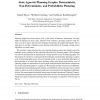Free Online Productivity Tools
i2Speak
i2Symbol
i2OCR
iTex2Img
iWeb2Print
iWeb2Shot
i2Type
iPdf2Split
iPdf2Merge
i2Bopomofo
i2Arabic
i2Style
i2Image
i2PDF
iLatex2Rtf
Sci2ools
AI
2011
Springer
2011
Springer
State agnostic planning graphs: deterministic, non-deterministic, and probabilistic planning
Planning graphs have been shown to be a rich source of heuristic information for many kinds of planners. In many cases, planners must compute a planning graph for each element of a set of states, and the naive technique enumerates the graphs individually. This is equivalent to solving a multiple-source shortest path problem by iterating a single-source algorithm over each source. We introduce a data-structure, the state agnostic planning graph, that directly solves the multiple-source problem for the relaxation introduced by planning graphs. The technique can also be characterized as exploiting the overlap present in sets of planning graphs. For the purpose of exposition, we first present the technique in deterministic planning to capture a set of planning graphs used in forward chaining search. A more prominent application of this technique is in belief state space planning, where each search node utilizes a set of planning graphs; an optimization to exploit state overlap between be...
| Added | 12 May 2011 |
| Updated | 12 May 2011 |
| Type | Journal |
| Year | 2011 |
| Where | AI |
| Authors | Daniel Bryce, William Cushing, Subbarao Kambhampati |
Comments (0)

